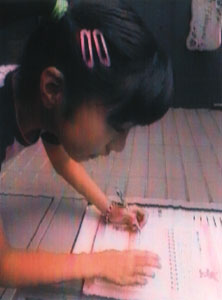|
 Kids in Japan are joining the Kids ISO 14000s program to help save the environment. This educational program is based on standards called ISO 14000s, which are set by the International Organization for Standardization (ISO) to conserve energy and help the earth. ISO 14000 is a standard for environmental management.
Kids in Japan are joining the Kids ISO 14000s program to help save the environment. This educational program is based on standards called ISO 14000s, which are set by the International Organization for Standardization (ISO) to conserve energy and help the earth. ISO 14000 is a standard for environmental management.
The Kids ISO 14000s program is a worldwide standard program for children. The program uses a standard format for environmental data, so that the data of any family in the world can be compared with others.
The earth is sick right now with a disease called "global warming." In the last 100 years the earth's temperature has gone up 0.5 degrees Celsius. Just like you when your body temperature goes up, it means the earth has a slight fever right now. By the year 2100, though, the earth's temperature could rise as much as two degrees or more. Two degrees is as dangerous for you as it is for the earth. If this happens the ice at the North and South Poles could melt, causing the level of oceans to rise. According to some scientists, this means that cities like London and New York could be under water by the year 2050.
Global warming is just one of many problems caused by pollution from humans through things like cars, factories, and trash. You can help stop or slow down these problems by using less energy and other valuable natural resources. In the Kids ISO 14000s program, kids learn how to do this through a six-step work plan.
Taking electricity as an example, first, you check the meter at home for one week to see how much electricity you are using. Next, you give yourself a grade to see how well you think you are doing at conservation.
 In the third step, with the help of a pamphlet, you come up with ideas on how to conserve energy. For example, you can unplug things you are not using, open the refrigerator less often, turn the lights off when you leave a room, and try to limit the amount of video games you play.
In the third step, with the help of a pamphlet, you come up with ideas on how to conserve energy. For example, you can unplug things you are not using, open the refrigerator less often, turn the lights off when you leave a room, and try to limit the amount of video games you play.
The fourth step is to get your family's help in your plan, because as one kid said, "I figured out I couldn't make much difference without my family's help."
In the fifth step you see how much your efforts paid off by checking the meter for one week again. Says one participant, "My heart was beating every time I went to check the meter, and when I saw a big difference I was really happy." Finally, you compare the first week's meter reading with the second week's reading to see if there was a difference and then grade yourself again.
Along with electricity, kids use this same plan to cut the amount of gas and water they use and the amount of trash they throw out. When they finish the two-week program they are graded and their official results are sent to them. Kids can continue the program at home for three months in order to receive a certificate from the ISO. They can also join a network for kids involved in the program in order to work together with others in Japan and around the world to make an even bigger difference. From start to finish, kids are the leaders in this fight to save the earth.
After an introductory course, kids can attempt the primary level of Kids ISO 14000s, the secondary level, and finally the highest level. The International Accreditation Committee, formed by international authorities, including the United Nations University, certifies those who pass each level.
More than 10,000 Japanese children took part in the Kids ISO 14000s program this summer, and the number is increasing dramatically. Now the Kids ISO 14000s program is spreading to Thailand, Indonesia, Australia, Brazil, and Europe. In the next year, children around the world will be able to compare their environmental activities with those in other countries through the Kids ISO 14000s Network.
The website of ArTech is found at http://www.artech.or.jp
Contact: info@artech.or.jp
Photos: (top) This pamphlet guides kids through the program; (above) A girl checks how well she is doing at conserving energy. (ArTech)
|

